fuel pressure MERCEDES-BENZ C-CLASS COUPE 2021 Owners Manual
[x] Cancel search | Manufacturer: MERCEDES-BENZ, Model Year: 2021, Model line: C-CLASS COUPE, Model: MERCEDES-BENZ C-CLASS COUPE 2021Pages: 549, PDF Size: 9.74 MB
Page 6 of 549
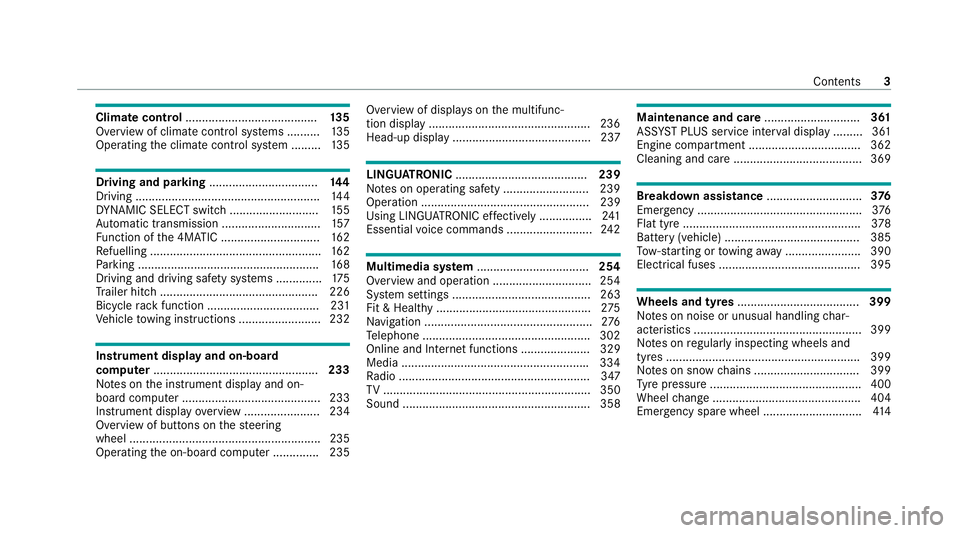
Climate control
........................................ 13 5
Overview of climate contro l systems ..........1 35
Operating the climate control sy stem ......... 13 5 Driving and pa
rking ................................. 14 4
Driving ........................................................ 14 4
DY NA MIC SELECT switch ........................... 15 5
Au tomatic transmission .............................. 157
Fu nction of the 4MATIC .............................. 16 2
Re fuelling .................................................... 16 2
Pa rking ...................................................... .168
Driving and driving saf ety sy stems .............. 175
Tr ailer hit ch................................................ 226
Bicycle rack function .................................. 231
Ve hicle towing instructions ........................ .232 Instrument display and on-board
comp
uter.................................................. 233
No tes on the instrument display and on-
board computer .......................................... 233
Instrument display overview ...................... .234
Overview of buttons on thesteering
wheel ..........................................................2 35
Operating the on-board computer .............. 235 Overview of displa
yson the multifunc‐
tion display .................................................2 36
Head-up display .......................................... 237 LING
UATRONIC ........................................ 239
No tes on operating saf ety .......................... 239
Ope ration ................................................... 239
Using LINGU ATRO NIC ef fectively ................ 241
Essential voice commands .......................... 24 2 Multimedia sy
stem .................................. 254
Overview and operation .............................. 254
Sy stem settings .......................................... 263
Fit & Healt hy............................................... 275
Na vigation ................................................... 276
Te lephone .................................................. .302
Online and Internet functions ..................... 329
Media ........................................................ .334
Ra dio .......................................................... 347
TV ............................................................... 350
Sound ......................................................... 358 Main
tenance and care ............................. 361
ASS YST PLUS service inter val display ........ .361
Engine compartment .................................. 362
Cleaning and care ....................................... 369 Breakdown assistance
.............................376
Emergency ................................................. .376
Flat tyre ...................................................... 378
Battery (vehicle) ......................................... 385
To w- starting or towing away ....................... 390
Electrical fuses ........................................... 395 Wheels and tyres
..................................... 399
No tes on noise or unusual handling char‐
acteristics .................................................. .399
No tes on regular lyinspecting wheels and
tyres .......................................................... .399
No tes on snow chains ................................ 399
Ty re pressure .............................................. 400
Wheel change ............................................ .404
Emergency spa rewheel .............................. 414 Con
tents 3
Page 14 of 549
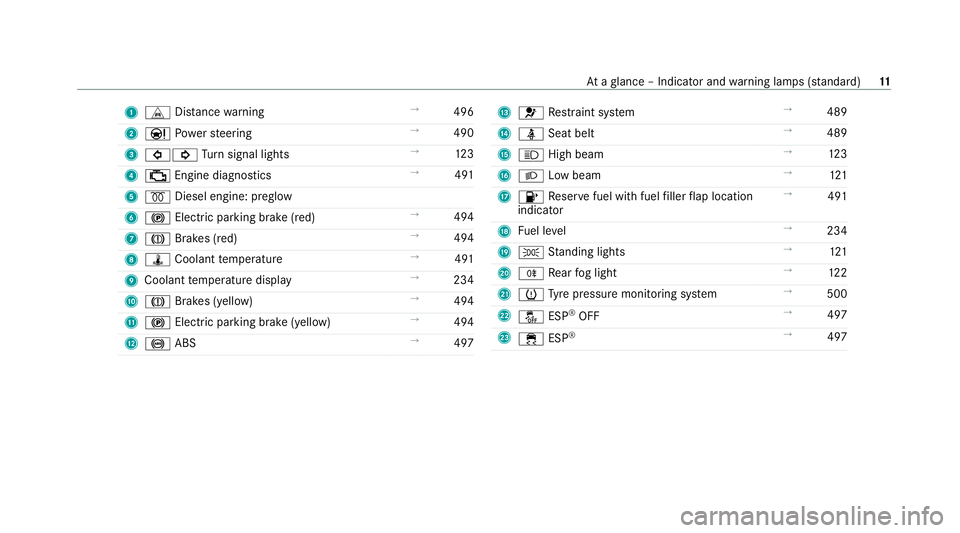
1
L Distance warning →
496
2 Ð Powe rst eering →
490
3 #! Turn signal lights →
12 3
4 ; Engine diagnostics →
491
5 % Diesel engine: preglow
6 ! Electric pa rking brake (red) →
494
7 J Brakes (red) →
494
8 ÿ Coolant temp erature →
491
9 Coolant temp erature display →
234
A J Brakes (yellow) →
494
B ! Electric pa rking brake (yellow) →
494
C ! ABS →
497 D
6 Restra int sy stem →
489
E ü Seat belt →
489
F K High beam →
12 3
G L Low beam →
121
H 8 Reser vefuel with fuel filler flap location
indicator →
491
I Fuel le vel →
234
J T Standing lights →
121
K R Rear fog light →
12 2
L h Tyre pressure monitoring sy stem →
500
M å ESP®
OFF →
497
N ÷ ESP®
→
497 At
aglance – Indicator and warning lamps (s tanda rd) 11
Page 16 of 549
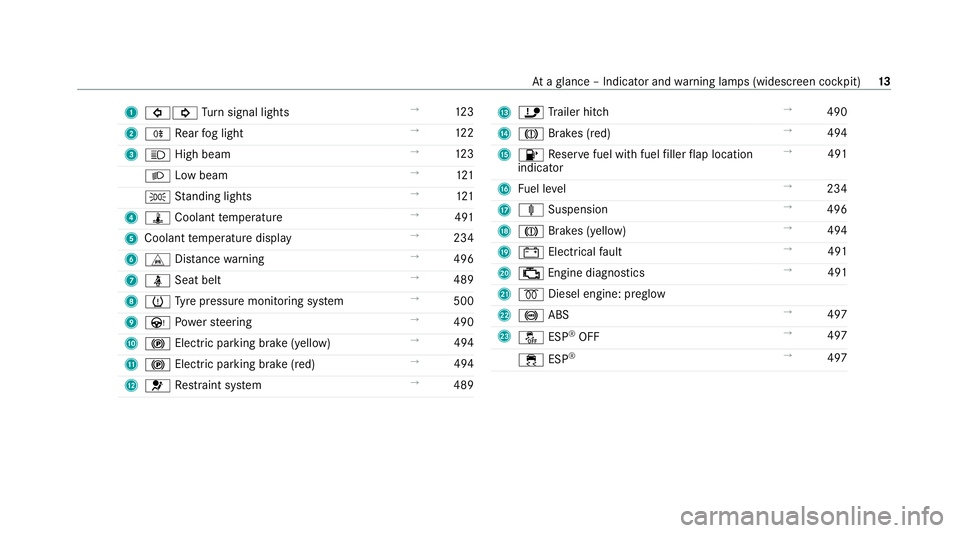
1
#! Turn signal lights →
12 3
2 R Rear fog light →
12 2
3 K High beam →
12 3
L Low beam →
121
T Standing lights →
121
4 ÿ Coolant temp erature →
491
5 Coolant temp erature display →
234
6 L Distance warning →
496
7 ü Seat belt →
489
8 h Tyre pressure monitoring sy stem →
500
9 Ù Powe rst eering →
490
A ! Electric pa rking brake (yellow) →
494
B ! Electric parking brake (red) →
494
C 6 Restra int sy stem →
489 D
ï Trailer hit ch →
490
E J Brakes (red) →
494
F 8 Reser vefuel with fuel filler flap location
indicator →
491
G Fuel le vel →
234
H ä Suspension →
496
I J Brakes (yell ow) →
494
J # Electrical fault →
491
K ; Engine diagnostics →
491
L % Diesel engine: preglow
M ! ABS →
497
N å ESP®
OFF →
497
÷ ESP®
→
497 At
aglance – Indicator and warning lamps (widesc reen cockpit) 13
Page 22 of 549
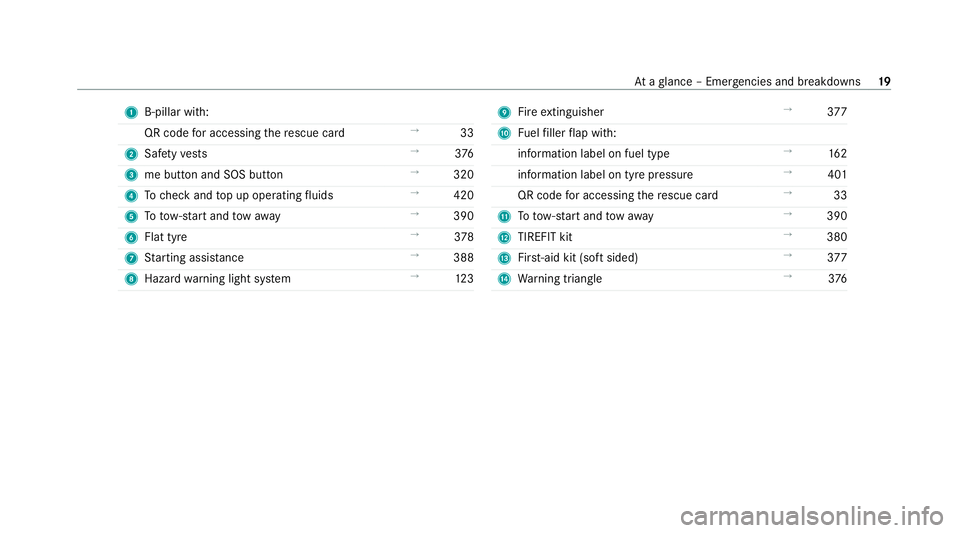
1
B-pillar wi th:
QR code for accessing there scue card →
33
2 Safetyve sts →
376
3 me button and SOS button →
320
4 Tocheck and top up operating fluids →
420
5 Totow- start and tow aw ay →
390
6 Flat tyre →
378
7 Starting assis tance →
388
8 Haza rdwa rning light sy stem →
12 3 9
Fire extinguisher →
377
A Fuelfiller flap with:
information label on fuel type →
16 2
information label on tyre pressure →
401
QR code for accessing there scue card →
33
B Totow- start and tow aw ay →
390
C TIREFIT kit →
380
D First-aid kit (so ftsided) →
377
E Warning triangle →
376 At
aglance – Emer gencies and breakdowns 19
Page 24 of 549
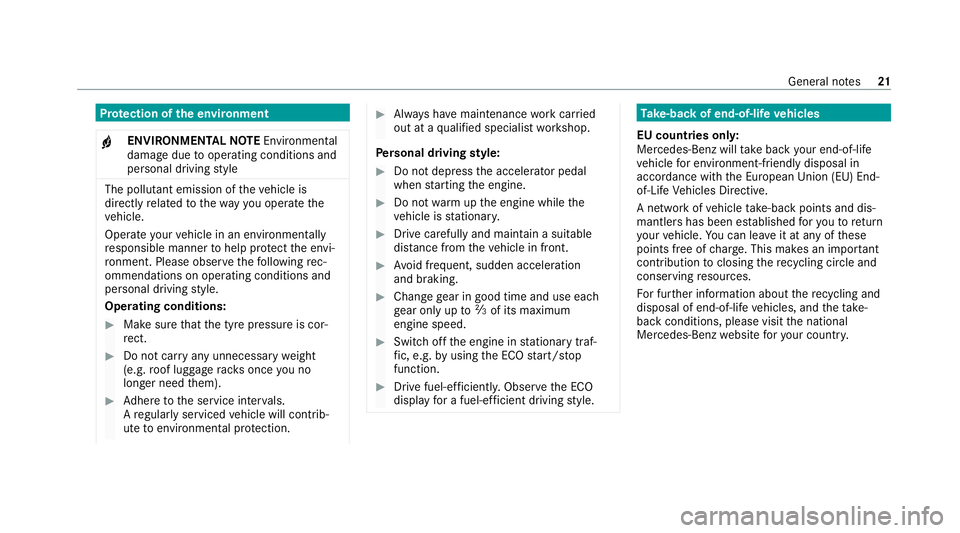
Pr
otection of the environment
+ ENVIRONMENTAL
NOTEEnvironmental
dama gedue tooperating conditions and
personal driving style The pollutant emission of
theve hicle is
directly related tothewa yyo u operate the
ve hicle.
Operate your vehicle in an environmentally
re sponsible manner tohelp pr otect the envi‐
ro nment. Please obser vethefo llowing rec‐
ommendations on ope rating conditions and
pe rsonal driving style.
Operating conditions: #
Make sure that the tyre pressure is cor‐
re ct. #
Do not car ryany unnecessary weight
(e.g. roof luggage rack s once you no
lon ger need them). #
Adhere tothe service inter vals.
A regularly serviced vehicle will contri b‐
ute toenvironmen tal pr otection. #
Alw ays ha vemaintenance workcar ried
out at a qualified specialist workshop.
Pe rsonal driving style: #
Do not depress the accelera tor pedal
when starting the engine. #
Do not warm upthe engine while the
ve hicle is stationar y. #
Drive carefully and maintain a suitable
di st ance from theve hicle in front. #
Avoid frequent, sudden acceleration
and braking. #
Change gear in good time and use each
ge ar on lyup toÔ of its maximum
engine speed. #
Switch off the engine in stationary traf‐
fi c, e.g. byusing the ECO start/ stop
function. #
Drive fuel-ef ficiently. Obser vethe ECO
display for a fuel-ef ficient driving style. Ta
ke -back of end-of-life vehicles
EU countries onl y:
Mercedes-Benz will take back your end-of-life
ve hicle for environment-friendly disposal in
accordance with the European Union(EU) End-
of-Life Vehicles Directive.
A network of vehicle take -ba ckpoints and dis‐
mantlers has been es tablished foryo uto return
yo ur vehicle. You can lea veit at any of these
points free of charge . This makes an impor tant
contribution toclosing there cycling circle and
conse rving resources.
Fo r fur ther information about there cycling and
disposal of end-of-li fevehicles, and theta ke-
back conditions, please visit the national
Mercedes-Benz website foryo ur count ry. Gene
ral no tes 21
Page 79 of 549
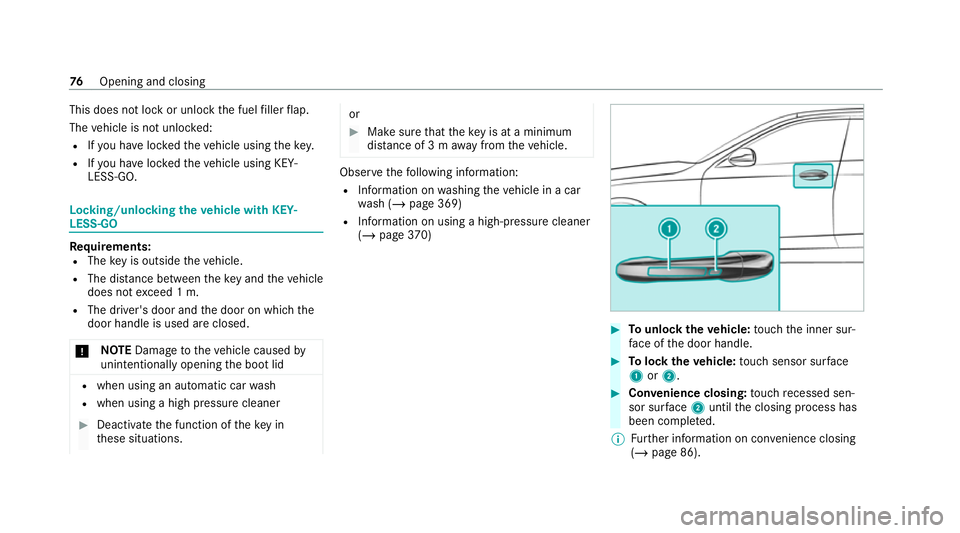
This does not lock or unlock
the fuel filler flap.
The vehicle is not unloc ked:
R Ifyo u ha veloc kedth eve hicle using thekey.
R Ifyo u ha veloc kedth eve hicle using KEY‐
LESS-GO. Locking/unlocking
theve hicle with KEY‐
LESS-GO Re
quirements:
R The key is outside theve hicle.
R The dis tance between theke y and theve hicle
does not exceed 1 m.
R The driver's door and the door on which the
door handle is used are closed.
* NO
TEDama getotheve hicle caused by
unin tentionally opening the boot lid R
when using an automatic car wash
R when using a high pressure cleaner #
Deactivate the function of theke y in
th ese situations. or
#
Make sure that theke y is at a minimum
dis tance of 3 maw ay from theve hicle. Obser
vethefo llowing information:
R Information on washing theve hicle in a car
wa sh (/ page 369)
R Information on using a high-pressure cleaner
(/ page 370) #
Tounlo cktheve hicle: touch the inner sur‐
fa ce of the door handle. #
Tolock theve hicle: touch sensor sur face
1 or2. #
Convenience closing: touch recessed sen‐
sor su rface 2until the closing process has
been comple ted.
% Further information on con venience closing
(/ page 86). 76
Opening and closing
Page 150 of 549
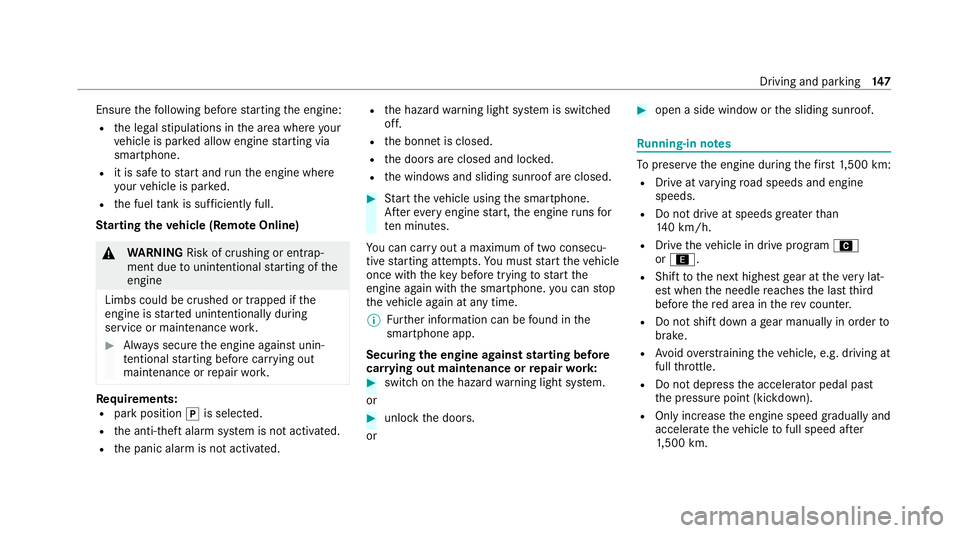
Ensu
rethefo llowing before starting the engine:
R the legal stipulations in the area where your
ve hicle is par ked allow engine starting via
smartphone.
R it is safe tostart and runth e engine where
yo ur vehicle is par ked.
R the fuel tank is su fficiently full.
St arting theve hicle (Remo teOnline) &
WARNING Risk of crushing or entrap‐
ment due tounin tentional starting of the
engine
Limbs could be crushed or trapped if the
engine is star ted unintentionally during
service or maintenance work. #
Alw ays secure the engine against unin‐
te ntional starting before car rying out
maintenance or repair work. Re
quirements:
R park position jis selected.
R the anti- theft alarm sy stem is not activated.
R the panic alarm is not activated. R
the hazard warning light sy stem is switched
off.
R the bonn etis closed.
R the doors are closed and loc ked.
R the windo wsand sliding sun roof are closed. #
Start theve hicle using the smartphone.
Af tereve ryengine start, the engine runs for
te n minu tes.
Yo u can car ryout a maximum of two consecu‐
tive starting attem pts. Yo u must start theve hicle
once with theke y before trying tostart the
engine again with the smartphone. you can stop
th eve hicle again at any time.
% Further information can be found in the
smartphone app.
Securing the engine against starting before
car rying out maintenance or repair work: #
switch on the hazard warning light sy stem.
or #
unlock the doors.
or #
open a side window or the sliding sunroof. Ru
nning-in no tes To
preser vethe engine during thefirs t1, 500 km:
R Drive at varying road speeds and engine
speeds.
R Do not drive at speeds greater than
14 0 km/h.
R Drive theve hicle in drive program A
or ;.
R Shift tothe next highest gear at theve ry lat‐
est when the needle reaches the last third
before there d area in there v counter.
R Do not shift down a gear manually in order to
brake.
R Avoid overstraining theve hicle, e.g. driving at
full thro ttle.
R Do not depress the accelera tor pedal past
th e pressure point (kickdown).
R Only increase the engine speed gradually and
accelera tetheve hicle tofull speed af ter
1, 500 km. Driving and parking
147
Page 164 of 549
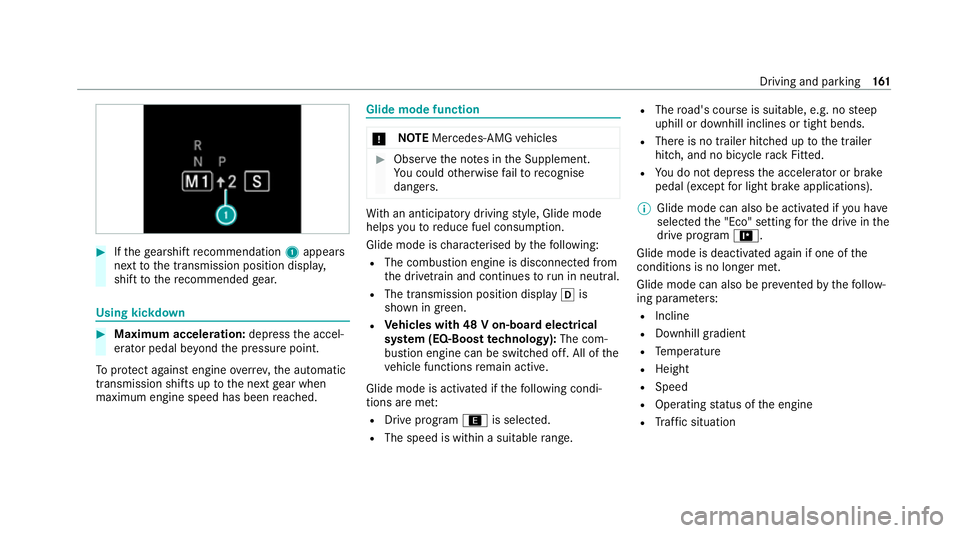
#
Ifth ege arshift recommendation 1appea rs
next tothe transmission position displa y,
shift tothere commended gear. Using kickd
own #
Maximum acceleration: depressthe accel‐
erator pedal be yond the pressure point.
To protect against engine overrev ,th e automatic
transmission shifts up tothe next gear when
maximum engine speed has been reached. Glide mode function
*
NO
TEMercedes-AMG vehicles #
Obser vethe no tes in the Supplement.
Yo u could otherwise failto recognise
dangers. Wi
th an anticipatory driving style, Glide mode
helps youto reduce fuel consum ption.
Glide mode is characterised bythefo llowing:
R The combustion engine is disconnected from
th e driv etra in and continues torun in neutral.
R The transmission position displ ayh is
shown in green.
R Vehicles with 48 V on-board electrical
sy stem (EQ-Boost technology): The com‐
bustion engine can be switched off. All of the
ve hicle functions remain active.
Glide mode is activated if thefo llowing condi‐
tions are me t:
R Drive prog ram ; is selected.
R The speed is within a suita blerange. R
The road's course is suitable, e.g. no steep
uphill or downhill inclines or tight bends.
R There is no trailer hitched up tothe trailer
hitch, and no bicycle rack Fitted.
R You do not depress the accelera tor or brake
pedal (e xcept for light brake applications).
% Glide mode can also be activated if you ha ve
selected the "Eco" setting forth e drive in the
drive prog ram =.
Glide mode is deactivated again if one of the
conditions is no longer met.
Glide mode can also be pr evented bythefo llow‐
ing parame ters:
R Incline
R Downhill gradient
R Temp erature
R Height
R Speed
R Operating status of the engine
R Traf fic situation Driving and pa
rking 161
Page 168 of 549
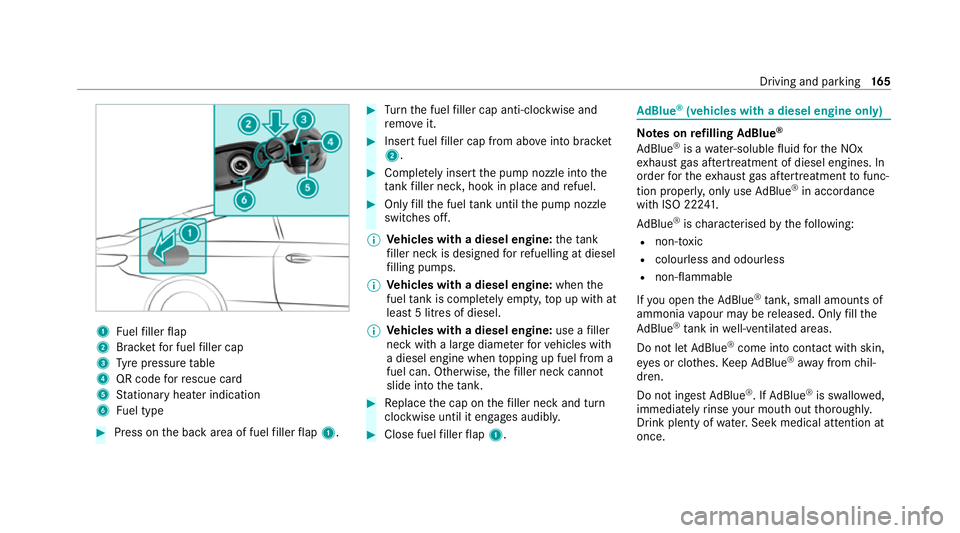
1
Fuelfiller flap
2 Brac ketfo r fuel filler cap
3 Tyre pressure table
4 QR code forre scue card
5 Stationary heater indication
6 Fuel type #
Press on the back area of fuel filler flap 1. #
Turn the fuel filler cap anti-clockwise and
re mo veit. #
Insert fuel filler cap from abo veinto brac ket
2 . #
Comple tely inse rtthe pump nozzle into the
ta nk filler nec k,hook in place and refuel. #
Only fill th e fuel tank until the pump nozzle
switches off.
% Vehicles with a diesel engine: theta nk
fi ller neck is designed forre fuelling at diesel
fi lling pumps.
% Vehicles with a diesel engine: whenthe
fuel tank is compl etely em pty, top up with at
least 5 litres of diesel.
% Vehicles with a diesel engine: use afiller
neck with a lar gediame terfo rve hicles with
a diesel engine when topping up fuel from a
fuel can. Otherwise, thefiller neck cannot
slide into theta nk. #
Replace the cap on thefiller neck and turn
clockwise until it engages audibl y. #
Close fuel filler flap 1. Ad
Blue ®
(vehicles with a diesel engine on ly) Note
s onrefilling AdBlue ®
Ad Blue ®
is a wate r-soluble fluid forth e NOx
ex haust gas af tertre atment of diesel engines. In
order forth eex haust gas af tertre atment tofunc‐
tion proper ly, only use AdBlue ®
in acco rdance
with ISO 22 241.
Ad Blue ®
is ch aracterised bythefo llowing:
R non-t oxic
R colourless and odourless
R non-flammable
If yo u open theAd Blue ®
tank, small amounts of
ammonia vapour may be released. Only fill the
Ad Blue ®
tank in well-ventilated areas.
Do not let AdBlue ®
come into contact wi thskin,
ey es or clo thes. Keep AdBlue ®
aw ay from chil‐
dren.
Do not ingest AdBlue ®
. If AdBlue ®
is swallo wed,
immediately rinse your mouth out thoroughly.
Drink plenty of water.Seek medical attention at
once. Driving and pa
rking 16 5
Page 374 of 549
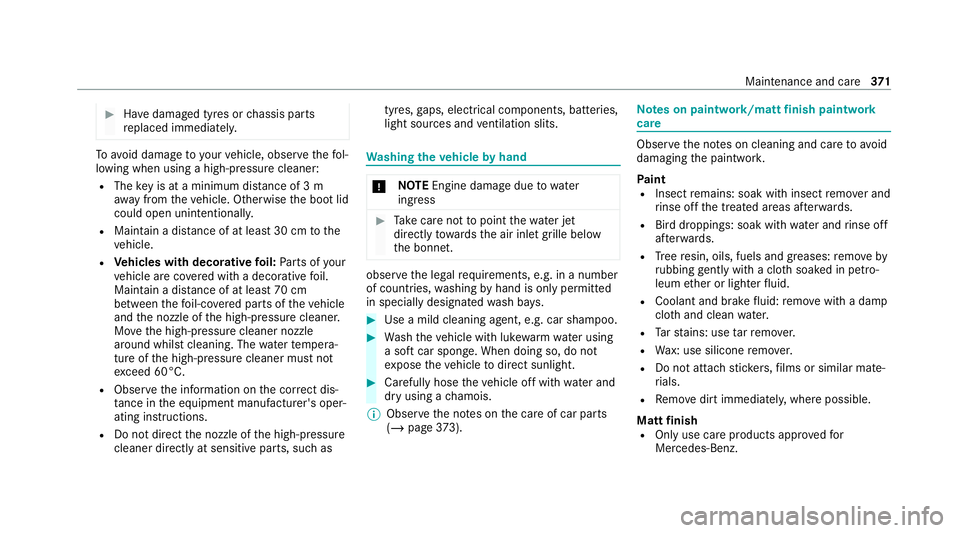
#
Have damaged tyres or chassis parts
re placed immediatel y. To
avo id damage to yourvehicle, obser vethefo l‐
lowing when using a high-pressure cleaner:
R The key is at a minimum distance of 3 m
aw ay from theve hicle. Otherwise the boot lid
could open unintentionall y.
R Maintain a dis tance of at least 30 cm tothe
ve hicle.
R Vehicles with deco rative foil: Parts of your
ve hicle are co vered with a decorative foil.
Maintain a dis tance of at least 70 cm
between thefo il-c ove red parts of theve hicle
and the nozzle of the high-pressure cleaner.
Mo vethe high-pressure cleaner nozzle
around whilst cleaning. The waterte mp era‐
ture of the high-pressure cleaner must not
exc eed 60°C.
R Obser vethe information on the cor rect dis‐
tan ce in the equipment manufacturer's oper‐
ating instructions.
R Do not direct the nozzle of the high-pressure
cleaner directly at sensitive parts, such as tyres,
gaps, elect rical components, batteries,
light sou rces and ventilation slits. Wa
shing theve hicle byhand *
NO
TEEngine dama gedue towa ter
ing ress #
Take care not topoint thewate r jet
directly towa rdsth e air inlet grille below
th e bonn et. obser
vethe legal requ irements, e.g. in a number
of countries, washing byhand is only permitted
in specially designated wash ba ys. #
Use a mild cleaning agent, e.g. car shampoo. #
Washtheve hicle with luk ewarmwate r using
a soft car sponge. When doing so, do not
ex pose theve hicle todirect sunlight. #
Carefully hose theve hicle off with water and
dry using a chamois.
% Obse rveth e no tes on the care of car parts
(/ page 373). Note
s on paint work/matt finish paint work
care Obse
rveth e no tes on cleaning and care toavo id
damaging the paintwor k.
Pa int
R Insect remains: soak with insect remo ver and
ri nse off the treated areas af terw ards.
R Bird droppings: soak with water and rinse off
af te rw ards.
R Tree resin, oils, fuels and greases: remo veby
ru bbing gently wi tha clo thsoaked in petro‐
leum ether or lighter fluid.
R Coolant and brake fluid: remo vewith a damp
clo thand clean water.
R Tarst ains: use tar remo ver.
R Wax: use silicone remo ver.
R Do not attach sticke rs,fi lms or similar mate‐
ri als.
R Remo vedirt immediately, where possible.
Matt finish
R Only use care products appr ovedfor
Mercedes-Benz. Maintenance and care
371